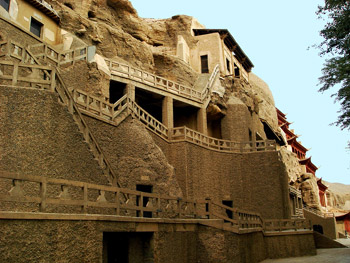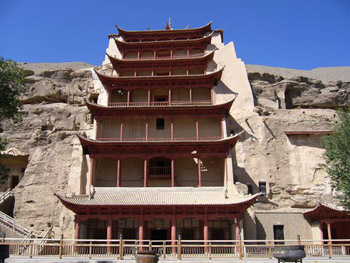 |
 |
Mogao Grottoes, again known as “Thousand Buddha Caves”, are located at the cliffs of the Soughing Sand Hill some 25 kilometers to the southeast of the city of Dunhuang. The name of the grottoes is a derivation of the township named Mogao. Being the largest, the most well-known grottoes of Buddhism art in China they were caved out on the third and fourth floor, extending a length of 1.6 kilometers along the cliff. The grotto was initially dug in 366, the 2nd year under the reign Jianyuan of the Former Qin and now in existence are 492 caves with a total of 45,000 square meters of murals and 2,400 colored sculptures housed in them. The sizes of the caves are varied with the big ones looking robust and virile while the small icons are exquisite and delicate. The artistic attainment is so profound and imagination so rich that set people tongue-tied when viewing them. The fresco-contents are quite rich with most of them in connection with the Buddhism, for instance, the life story of Sakyamuni and his good deeds to others by sacrificing what was of his own. In addition, there are still a great number of Buddha-figures, Bodhisattvas, heavenly devas, tutelary deities, flying Apsaras and flowers and birds as well as other animals. Though they’ve been exposed to weathering in winds and sandstorms for over thousand years the colors of the murals are still bright with clear curve lines, that can not help but set people acclaim for the accomplishments in art and the creative sprits of the artists in China’s ancient times. The Mogao Grottoes are the largest “World Treasure-house of Art” so far in existence in the world and so the UNESCO listed it as one of the world cultural legacies in December in 1987.
Cited from:(Han Rongliang & Han Zhiyu (2006). Guide to Gansu [M].Beijing: China Travel and Tourism Press)


